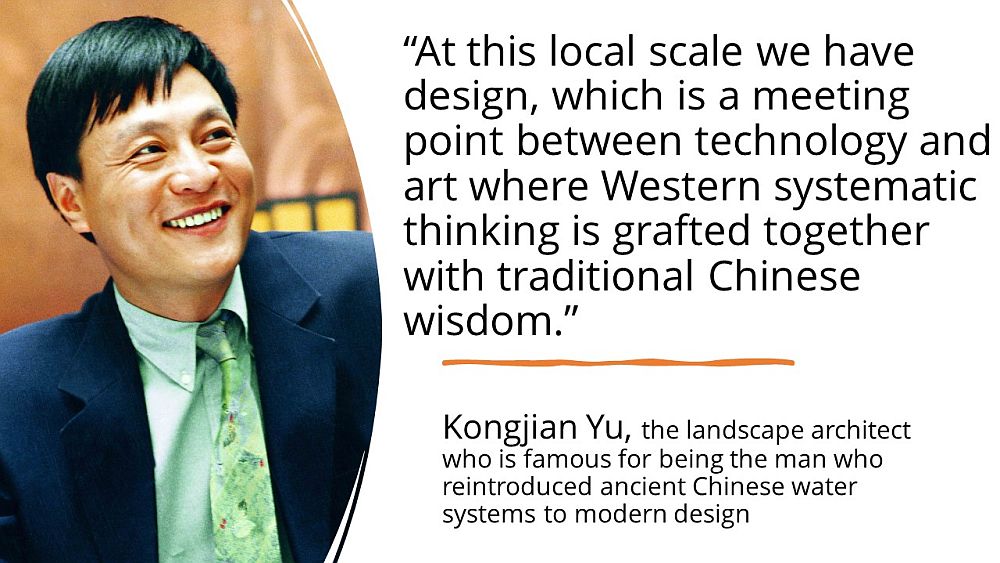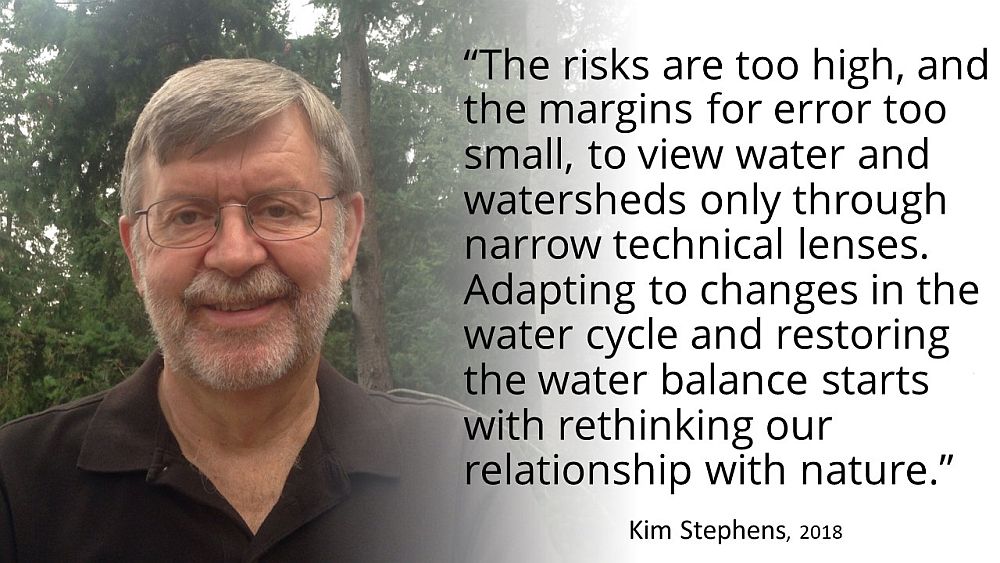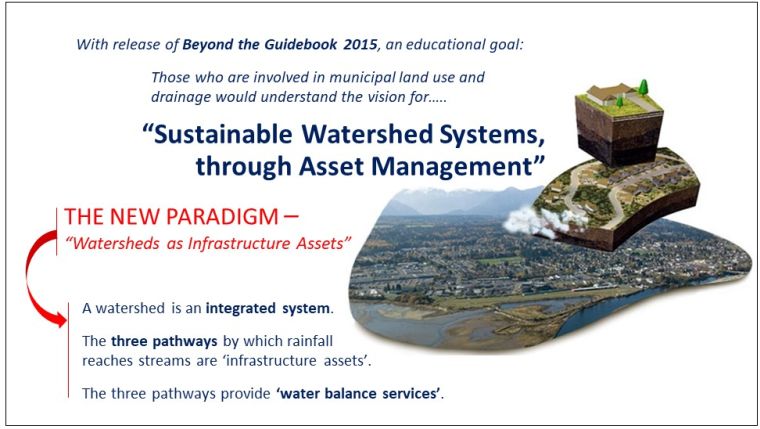RESTORE THE BALANCE IN THE WATER BALANCE: “From green roofs in Toronto to Vancouver’s rain city strategy, Canadian cities are looking to become ‘sponges’ in order to help mitigate some of the effects of extreme rainfall events,” wrote Morgan Lowrie of the Canadian Press (October 2023)
Note to Reader:
Chinese cities are suffering from floods more often than most. At the same time, many cities in China face a serious water shortage. The need to confront both water shortages and urban flooding has created a major infrastructure challenge for Chinese city planners. Widespread adoption of rainwater capture techniques is seen as a way to alleviate drought as well as flooding.
A decade ago, Chinese President Xi Jinping offered a new way to think about flooding and drought. At China’s Central Government Conference on Urbanization in 2013, he announced that cities should act “like sponges.”

Canadian municipalities looking to become ‘spongier’ to catch and absorb rainwater, build climate resilience
“While the concept of building a ‘sponge city’ isn’t new,” wrote Morgan Lowrie, Canadian Press editor/reporter, “it’s an idea that more and more municipalities are embracing as they cope with extreme weather. The goal is to reverse some of the harm done by decades of car-oriented urban development.”
“Green infrastructure can be incorporated into a landscape in many ways, from simple tree planting to rain gardens and more complex bioretention systems that involve layers of filtering. Across Canada, cities appear to be jumping on board.”
To Learn More:
To read the complete story by Morgan Lowrie, download a PDF copy of Canadian municipalities looking to become ‘spongier’ to catch and absorb rainwater, build climate resilience.

Kongjian Yu’s first project, Zhongshan Shipyard Park, blends “rustic landscapes and urban industry”
“Sponge Cities” – a catchy way to describe the goal in restoring the capacity of the urban landscape to absorb water and release it naturally
 In 2013, at China’s Central Government Conference on Urbanization, President Xi Jinping injected a new term into the global urban design vocabulary when he proclaimed that cities should “act like sponges” and launched China’s Sponge City program. His proclamation came with substantial funding to experiment with ways cities can absorb precipitation.
In 2013, at China’s Central Government Conference on Urbanization, President Xi Jinping injected a new term into the global urban design vocabulary when he proclaimed that cities should “act like sponges” and launched China’s Sponge City program. His proclamation came with substantial funding to experiment with ways cities can absorb precipitation.
 And then, in August 2017, the Senate of Berlin released its Sponge City Strategy. It is designed to tackle two issues – heat and flooding – by imitating nature and capturing rainwater where it falls. “During the past 12 years we made quite good progress to install the ‘sponge-city concept’ or ‘decentralized stormwater management’ as we call it in Germany in the daily planning process,” states Dr. Heiko Sieker, urban hydologist.
And then, in August 2017, the Senate of Berlin released its Sponge City Strategy. It is designed to tackle two issues – heat and flooding – by imitating nature and capturing rainwater where it falls. “During the past 12 years we made quite good progress to install the ‘sponge-city concept’ or ‘decentralized stormwater management’ as we call it in Germany in the daily planning process,” states Dr. Heiko Sieker, urban hydologist.
 Meanwhile, the City of Philadelphia is in Year 7 of a 25-year program to implement its Green City, Clean Waters program to create a citywide mosaic of green infrastructure and restore the water balance. Howard Neukrug fundamentally changed Philadelphia’s relationship with nature. “Changing the world—or even one small piece of it—requires a lot of trial and error. We divide the city into communities, needs, types, gradients, opportunities, public, private and quasi-government,” stated Howard Neukrug.
Meanwhile, the City of Philadelphia is in Year 7 of a 25-year program to implement its Green City, Clean Waters program to create a citywide mosaic of green infrastructure and restore the water balance. Howard Neukrug fundamentally changed Philadelphia’s relationship with nature. “Changing the world—or even one small piece of it—requires a lot of trial and error. We divide the city into communities, needs, types, gradients, opportunities, public, private and quasi-government,” stated Howard Neukrug.

The Landscape Architecture of Kongjian Yu
As an outcome of reintroducing ancient Chinese water systems to modern design, Kongjian Yu has transformed some of China’s most industrialized cities into standard bearers of green architecture. Yu’s designs aim to build resilience in cities faced with rising sea levels, droughts, floods and so-called “once in a lifetime” storms.
 “In order to increase the resilience of a natural system, it is important to find solutions beyond the level of the city and even nation. I’m talking about a whole global system, in which we think globally but must act locally,” states Kongjian Yu.
“In order to increase the resilience of a natural system, it is important to find solutions beyond the level of the city and even nation. I’m talking about a whole global system, in which we think globally but must act locally,” states Kongjian Yu.
“And at this local scale we have design, which is a meeting point between technology and art where Western systematic thinking is grafted together with traditional Chinese wisdom.”
“The mottos of the sponge city are: Retain, adapt, slow down and reuse.”
“Based on thousands of years of Chinese wisdom, the first strategy is to contain water at the origin, when the rain falls from the sky on the ground. We have to keep the water. The water captured by the sponge can be used for irrigation, for recharging the aquifer, for cleansing the soil and for productive use.”
“It’s important to make friends with water. We can make a water protection system a living system,” concludes Kongjian Yu.

Rethinking our relationship with nature is necessary because…
The warming of the planet’s atmosphere is causing water to move more quickly and disruptively through the global water cycle. Flood, drought, fire, wind and cold – extreme events are becoming the norm. Instabilities in the water cycle are increasingly apparent.
All one need do is reflect on what British Columbia has experienced in 2015, 2016 and 2017. Impacts are magnified by human interventions. We have arrived at a fork in the road.”
“The situation calls for a whole-systems approach to managing the water balance distribution where people live,” states Kim Stephens, Executive Director, Partnership for Water Sustainability in British Columbia.
“The risks are too high, and the margins for error too small, to view water and watersheds only through narrow technical lenses. Adapting to changes in the water cycle and restoring the water balance starts with rethinking our relationship with nature.”
Whole-System, Water Balance Approach
“The need to protect headwater streams and groundwater resources in British Columbia requires that communities expand their view – from one that looks at a site in isolation – to one that considers HOW all sites, the watershed landscape, streams and foreshores, groundwater aquifers, and PEOPLE function as a whole system” continues Kim Stephens.
“Inter-governmental collaboration and funding enable the Partnership for Water Sustainability in British Columbia to develop approaches, tools and resources; as well as provide teaching, training and mentoring.”
“Our educational goal is to build practitioner capacity within the local government setting to implement a whole-system, water balance approach branded as Sustainable Watershed Systems, through Asset Management.”

And be sure to apply tools and resources!
“The ‘sponge city’ metaphor is powerful and inspirational,” observes Kim Stephens. “As such, China, Berlin and Philadelphia are demonstrating that when there is a will, there is a way. Still, we urge the reader to take a moment to reflect upon their drivers for action – floods and droughts! They have learned the hard way that what happens on the land matters. And now, the ‘new normal’ of frequently recurring extremes has forced them to tackle the consequences of not respecting the water cycle.”
The Challenge
“Opportunities for land use and infrastructure servicing practitioners to make a difference are at the time of (re)development. To those folks we say: share and learn from those who are leading change; design with nature; ‘get it right’ at the front-end of the project; build-in ‘water resilience’; create a lasting legacy.”
“Many land and infrastructure professionals in this province do know in principle what they ought to do. However, there is still a gap between UNDERSTANDING and IMPLEMENTATION.”
“This results in a capacity-building challenge: It is one thing to provide practitioners with tools and resources, It is another matter for them to apply the tools, and use them correctly.”
Mission Possible
“Yes, British Columbia is progressing,” concludes Kim Stephens. “Yet communities could do so much more if they would capitalize on rather than miss opportunities. Apply the tools. Do what is right. Learn from experience. Adapt. Pass the baton.”
“The Partnership spotlight is on how to ‘bridge the gap’ between talk and action. As champions for the Whole-System, Water Balance Approach, we are developing tools and resources for use by local governments.”


